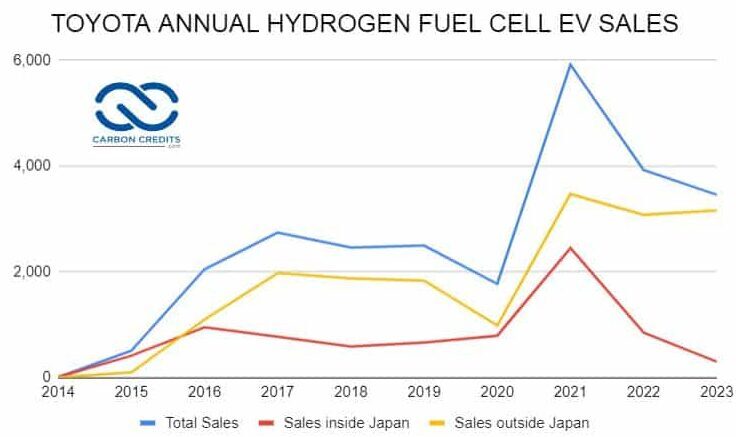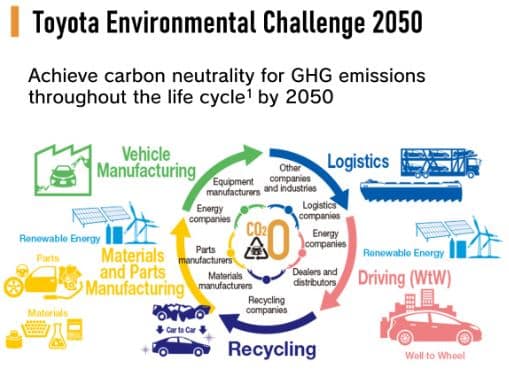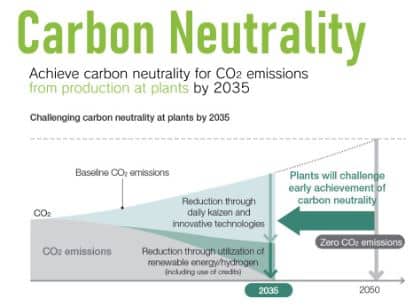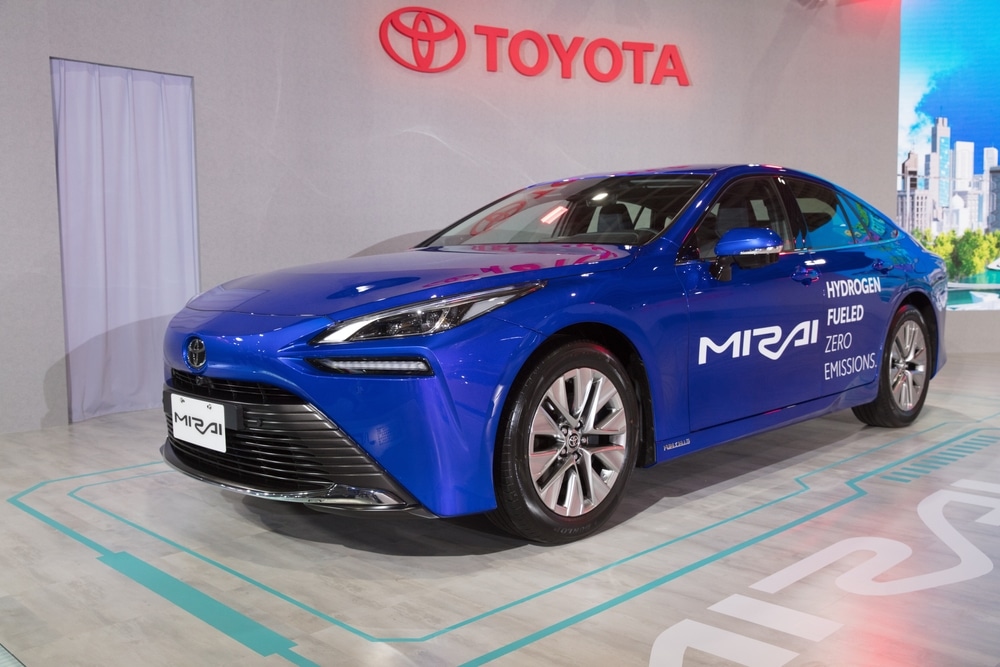It’s no secret that Toyota’s hydrogen fuel cell Mirai has not been successful in sales as the carmaker itself admitted. But that didn’t discourage the Japanese automaker from planning to accelerate the adoption of hydrogen fuel cell (FCEV) technology.
In its latest sales and production report, Toyota has shown year-on-year growth in both performance results globally.
Total sales of electrified vehicles, both inside and outside Japan as well as per region (North America, Europe, Asia, China, and other) have increased significantly. It’s also true across the board for reporting coverage – for September 2023, total from January-September 2023 and from April-September 2023.
Toyota’s FCEV Sales Performance
Toyota’s worldwide electric vehicle (EV) sales were up about 52% for the month of September. The same positive performance was achieved for 2023 (31%), and for the first half of fiscal year, April-September, (38%).
For FCEV sales, positive results are also observed for global sales but not for the outcome for Toyota’s home country. Hydrogen fuel cell EVs are also using an electric motor like a battery EV but it sources power from a fuel stack where hydrogen is stored.
Worldwide sales for FCEV increased for September, last nine months, and last six months by 166%, 22%, and 77%, respectively.
The remarkable results are all thanks to the carmaker’s sales outside Japan, with a whopping 289% increase for September. For the last 6 months and 9 months, figures were both up about 94% and 47%, respectively.
Looking at the yearly achievements, FCEV sales peaked in 2021 and painted a good picture overall. 2023 data is through September only, which the company believes to also increase YoY.
As Toyota aims to sell more by 2030, the company plans to tap into this technology that’s been touted as the future of mobility.

The Fight for Hydrogen Vehicle Goes On
The largest carmaker by sales has long placed a huge bet on FCEV as an alternative to fossil fuels. But the company’s sales of hydrogen vehicles weren’t that significant. It has only sold fewer than 22,000 hydrogen fuel cell Mirai since 2014.
The average annual number of FCEV sold was so insignificant compared to Toyota’s total vehicle sales. Expensive cost of the fuel and lack of hydrogen fueling stations are the two largest bottlenecks hindering sales growth.
Yet, this didn’t dissuade the car company to continue investing in and developing its hydrogen fuel cell technology.
In October, Isuzu and Toyota joined forces to mass produce a light hydrogen fuel cell truck. The truck is based on Isuzu’s light-duty truck platform and will be powered by Toyota’s hydrogen fuel cell system.
Toyota’s FCEV technology is also facing close rivalry from its peers, including Hyundai, Honda, Nissan, and Daimler. Hyundai has had fuel cell vehicles on the market for several years already. Meanwhile, Honda has also been experimenting with FCEV and improving it for some time.
Nonetheless, Toyota made headlines last July when it revealed plans to roll-out 200,000 hydrogen-powered vehicles, targeting Europe and China.
Such revelation is a major shift in Toyota’s focus, which announced intent to commercialize its game-changing solid-state battery by 2027. These next-gen batteries can potentially cut carbon emissions of EV batteries by 39%.
Reducing planet-warming emissions is one of the key drivers prompting Toyota, as well as other automakers, to invest in fossil fuel alternatives like FCEV. The ultimate goal is to bring the world to net zero emissions by 2050.
Toyota’s Net Zero Targets
For the Japanese car marker, that means achieving zero carbon emissions in three areas: lifecycle, new vehicle, and production at plants.
Life Cycle Zero CO2 Emission Target
The company aims to reduce GHG emissions by 30% throughout a vehicle’s life cycle by 2030 versus 2019 levels. As seen below, life cycle includes emissions from making materials and parts to vehicle manufacturing, logistics/delivery, driving, and recycling.
 GHG emissions cover energy consumption in Toyota Motor Corporation and financially consolidation subsidiary corporate activities (Scopes 1 and 2). It also includes GHG emissions from suppliers and customers in relation to vehicles under the company and its subsidiaries (Scope 3).
GHG emissions cover energy consumption in Toyota Motor Corporation and financially consolidation subsidiary corporate activities (Scopes 1 and 2). It also includes GHG emissions from suppliers and customers in relation to vehicles under the company and its subsidiaries (Scope 3).
New Vehicle Zero CO2 Emissions Target
In making new vehicles, Toyota aims to achieve carbon neutrality for average emissions (emissions from production of fuel and electricity and during vehicle operation) by 2050.
Reaching that goal means achieving its near-term targets for new vehicle average GHG emissions by 2030 and 2035 as follows:
- 2030: 33.3% GHG reduction from new vehicles vs. 2019 levels for passenger light duty vehicles and light commercial vehicles. For medium and heavy freight trucks, that’s 11.6% emissions reduction.
- 2035: over 50% GHG emissions reduction from new vehicles compared to the 2019 baseline.
Plant Zero CO2 Emissions Target
Finally, Toyota plans to achieve zero CO2 emissions from production at plants by midcentury. This includes CO2 emissions from energy use in Toyota and its subsidiary plants, as well as CO2 emissions from producing other Toyota brands, involving Scope 1 and 2 emissions).
Under this target, the Japanese automaker plans to tackle the environmental challenge at its factories with the following strategy.
 Part of the plan is to purchase carbon credits from other companies to neutralize CO2 emissions. However, Toyota didn’t disclose how much of that emissions would be addressed using the credits.
Part of the plan is to purchase carbon credits from other companies to neutralize CO2 emissions. However, Toyota didn’t disclose how much of that emissions would be addressed using the credits.
Toyota’s pursuit of hydrogen fuel cell technology continues, showcasing global sales growth despite challenges in its home country. With a focus on reducing planet-warming emissions and achieving net zero targets, the company remains committed to advancing its FCEV technology.

